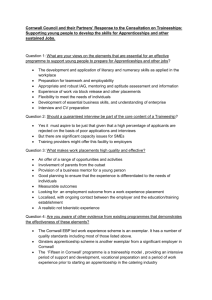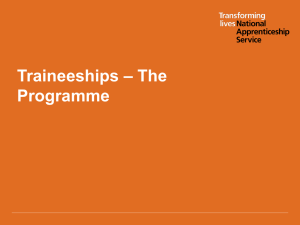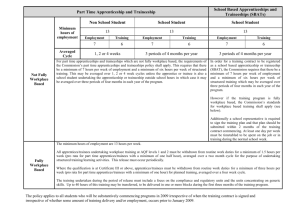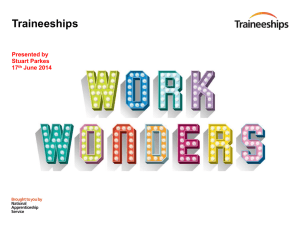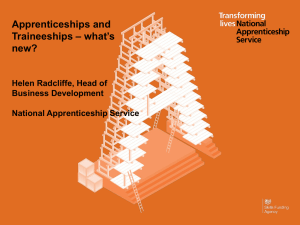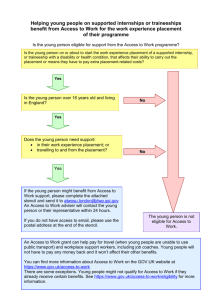Developing Work Ready Skills through Traineeships
advertisement
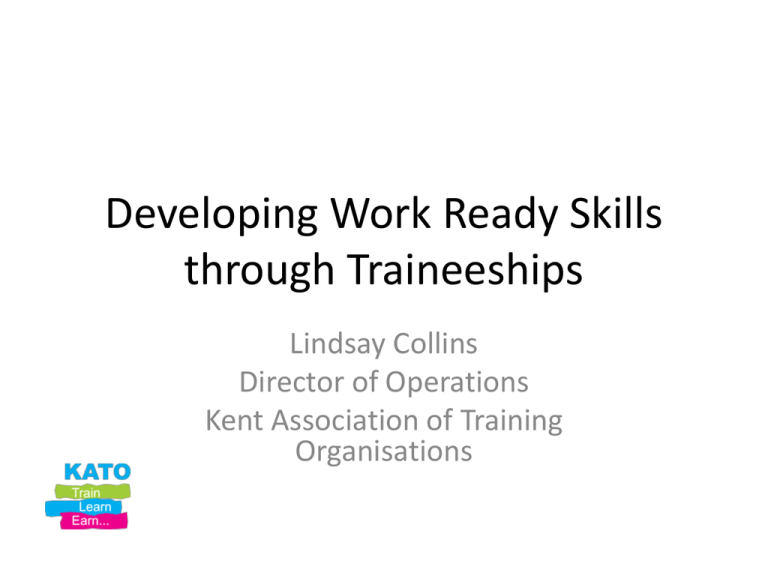
Developing Work Ready Skills through Traineeships Lindsay Collins Director of Operations Kent Association of Training Organisations Traineeships: what they are • Traineeships started 1 August 2013 and are part of the apprenticeships family. • A traineeship is designed to help young people who are focused on getting an apprenticeship or sustainable job but who do not yet have the skills or experience to compete successfully for vacancies. Traineeships run for a maximum of 6 months. • The traineeships programme has 3 core elements. • work placement • work preparation training • English and maths support, if required • You can access more information about the core elements in the Framework for delivery document Traineeships: who they are aimed at • Traineeships are available for young people aged 16-24 inclusive, including young people with Learning Difficulty Assessments or Education, Health and Care plans. A learner is able to start a traineeship up to the day before their 25th birthday. • The core target group for traineeships is young people who: – are not currently in a job and have little work experience, but who are focused on work, or the prospect of it – are aged 16 to 24 and qualified below a level 3 qualification – employers and training organisations believe have a reasonable chance of being ready for employment or an apprenticeship within 6 months of taking part in a traineeship programme What are benefits of a Traineeship for a young person? Traineeships have been developed in response to research showing that young people frequently lack the knowledge and experience employers expect in the workplace. Work preparation training will put young people in a better position to compete for an apprenticeship or other job. – Maths and English support to help give the literacy and numeracy skills needed to boost chances of getting a job, as well as improving long term prospects and earning potential over lifetime. – The opportunity to build a CV and get vital experience with local or national employers to learn about the business and the industry it operates in. – Employers at the centre of the work preparation training which ensures ‘work readiness’ and to gain confidence to take the first step to securing a job and starting career. – At the end of work experience placement either a job interview with the company if a role becomes available or a reference and an exit interview. What is the attraction for young people? • Traineeships are designed to lead to an Apprenticeship, job or other positive outcome • Guaranteed “real” employer experience • On the job training • No minimum qualifications required to enrol • Opportunity to try out a sector, job role or employer What are benefits of taking on a Trainee for employers? • Traineeships are an access point to a good pool of talent • Learners and employers gain support with pastoral care from the providers • Government funding supports these opportunities • Providers support recruitment and selection which is a free service • Trainees provide a young fresh pair of eyes, eager to be trained in your particular ways of working What are benefits of taking on a Trainee for employers? • ‘Try before your buy’, but with commitment to the long term, Traineeships offer an extended induction period • Traineeships form a helpful step towards a full Apprenticeship • Trainees are young people with the skills employers are looking for • Recruiting Trainees helps employers fulfil their Corporate Social Responsibility What Good looks like • Choice and relevance – Placement matched to the trainee’s areas of interest and aspiration, with young people getting involved in real activity rather than observation or mundane tasks. • Organisational readiness – Commitment from senior managers or owner/manager and a low ratio of trainees to experienced managers. What Good looks like • Written agreement – Made between the trainee, employer and provider setting out mutual expectations and commitments, including the training plan and arrangements for reviews. • A planned placement – A structured induction, clear objectives and integrated off-the-job training, with an identified mentor or buddy. • Feedback and review – Regular constructive feedback from managers and formal reviews at key stages with the manager, provider and trainee. Helpful resources for advisors • http://www.traineeship-staffsupport.co.uk/ • https://www.gov.uk/government/publica tions/traineeships-operationalinformation/traineeships-supportinginformation Thank you Questions?
